Written with the assistance of Phoebe Evans
Six portraits currently on display at the V&A offer a glimpse of life in Ukraine before the war with Russia began in 2022. They were taken by British photographer Mark Neville (b. 1966) over six years, during a simmering conflict sparked by Russia’s invasion of eastern and southern parts of Ukraine in 2014. While the strain of living with constant threat is more immediately evident in some photographs than others, they all portray the humanity and resilience of a population now under direct attack.
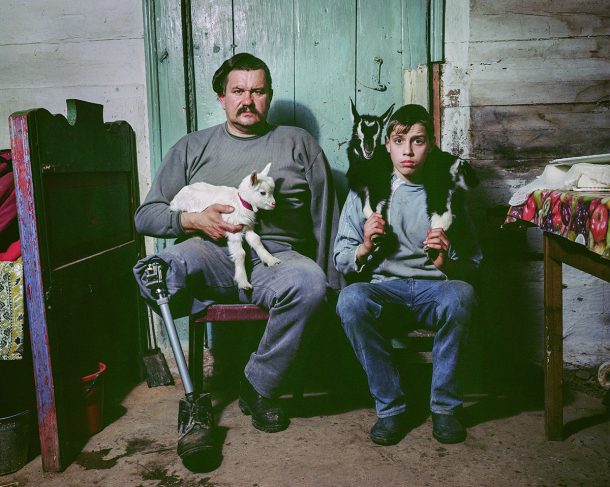
The photographs are drawn from Neville’s most recent publication, Stop Tanks With Books. He began photographing the people and places of Ukraine for the project in 2015, and moved to Kyiv in 2020. Distributed free to policy makers, politicians and activists just four days before the current war began, the book’s purpose is to focus international attention on the crisis in Ukraine and counteract the spread of fake news and falsities by the Kremlin about the Ukrainian people.
Stop Tanks With Books brings together 80 of Neville’s photographs, five short stories about the Russian occupation by Ukrainian poet and writer Lyuba Yakimchuk, and research from the Centre for Eastern European Studies in Berlin. Expressed predominantly through portraiture, the subjects range from sunbathers on the beach in Odessa and nightclubbers in Kyiv, to soldiers and civilians living in what was the old front line in eastern Ukraine. It opens with a clear statement as to why the world should care about the war, stating, ‘What is a stake in Ukraine is more than just the liberty of 43 million of her people. It is the fate of the ‘International Rules Based Order’ [an international declaration that guarantees basic liberties to all people] that has bought prosperity and freedom to so many since 1945.’ With this series, Neville has characterised the lives and experiences of those who have had these liberties stripped and encouraged greater consideration for the global implications of this ongoing war.
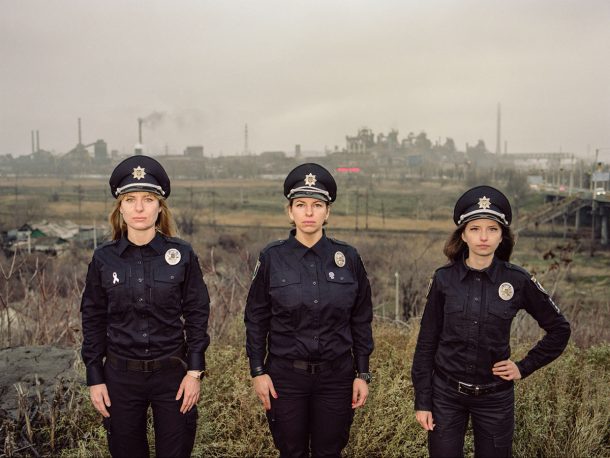
When these photographs were taken, the circumstances in Ukraine were very different. Lives, landscapes and structures have been dramatically changed. In the original context of Neville’s project, the photograph Policewomen, Mariupol, 2019, was understood as a statement of defiance conveyed through the brave faces of the changing Ukrainian police force. Taken in the southern port city of Mariupol, a trio of officers in uniform appear determined and stare steadfast into the camera’s lens. Although united by their purpose and uniform, small statements of individuality dot each woman: a watch, a silver belt buckle, painted nails and pins. Today, the whereabouts of these women is unknown and the bleak landscape behind them bears the immense scars of the war. While Mariupol was suffering from intense shelling and brutal attacks, the Avostal Iron and Steel plant sheltered thousands of Ukrainians in its tunnels and furnace rooms. This final bastion of Ukrainian Mariupol has now been surrendered to Russian forces. Just as the building disappears into a haze in the background of this picture, so too has it disappeared in reality.
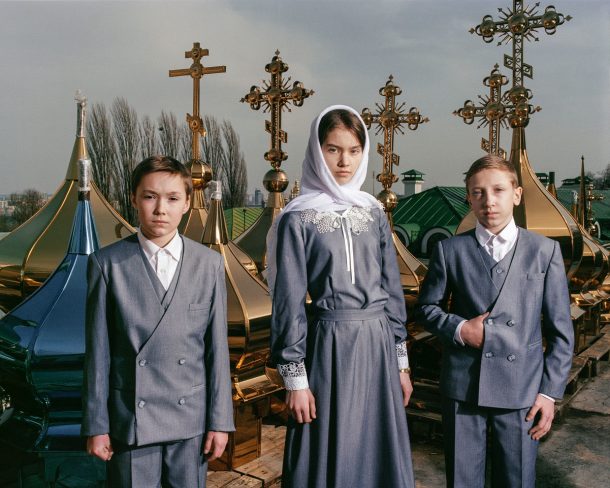
Among the many lives being impacted as a result of the war’s atrocities are those that were already in flux. The Choir at Kyiv Pechersk Lavra Orthodox Church, 2017, depicts three youthful singers. These children were among the 2.5 million people already displaced by the war in Donbas, east Ukraine, in 2017. In an essay in Stop Tanks with Books titled, ‘Making the Displaced Visible’, Gwendolyn Sasse and Alice Lackner describe how the process of displacement often renders individuals invisible. They write, ‘Akin to the calculation of war causalities, the displaced turn into a number and seemingly homogenous group shaped by identical experiences.’ This photograph subverts this inherited invisibility. The conviction behind the children’s gaze is complemented by Neville’s use of a large portable flash that boldly illuminates their dress and the pristine spires behind them. Posed against the backdrop of crosses and onion domes – a selection for sale to smaller churches from Kyiv Pechersk Lavra ‘shop’ – these children display a toughness far beyond their years.
The photograph Families eating on Arkadia Beach, Odesa, 2017, is perhaps the display’s strongest pictorial example of how Ukrainians have managed to get on with life despite the incredible stress of the conflict. Neville’s composition leads the eye around the scene, taking in the pink plastic bucket, beach towels, ice creams, patterned swimwear and bottles of beer. Sunlight soars in from the left, supplemented by Neville’s signature flash, casting long shadows along the concrete beach and illuminating the families eating and enjoying the sun. The photograph captures the conviviality of a holiday in Odesa, an annual pilgrimage made by many Ukrainians each year. And yet, Neville has explained that only moments before he took the photograph, two large military helicopters flew over the beach and within an instant, thousands of beachgoers fell completely silent.
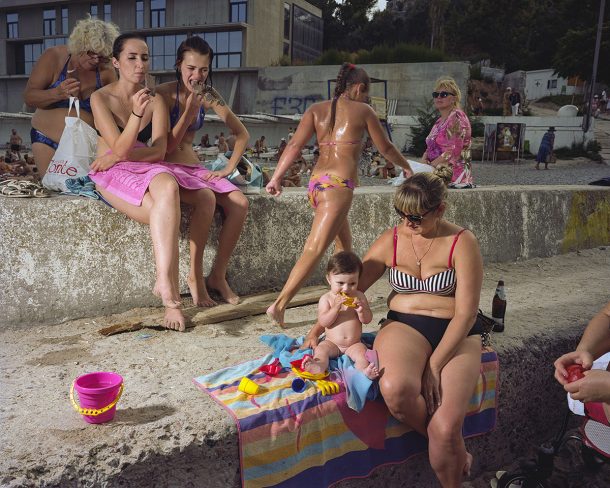
Looking over this group of photographs is simultaneously heartbreaking and inspiring. They tell a story of Ukraine’s dogged determination in the face of the relentless onslaught. Still based in Kyiv, Neville continues to work tirelessly to provide aid across the country through photographic and on-the-ground activity. Like those he photographed, he is committed to ensuring Ukrainian sovereignty.
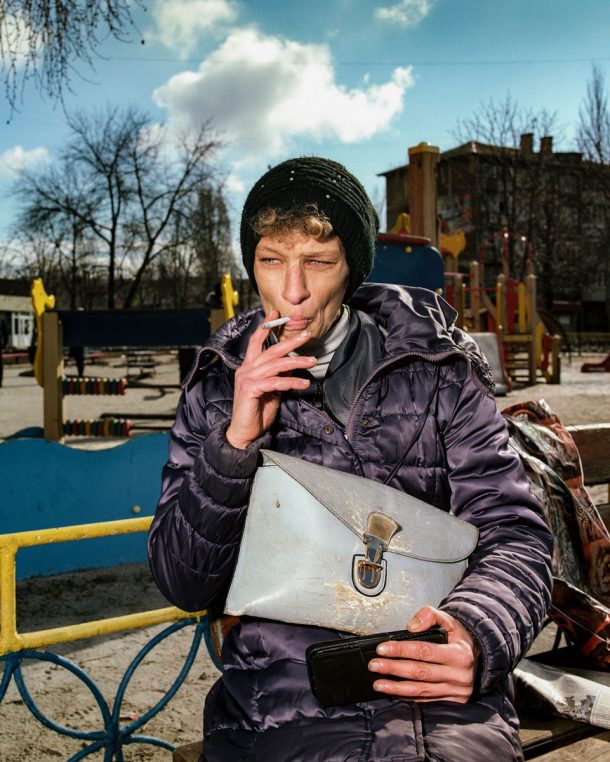
Stop Tanks With Books is just one facet of Neville’s growing body of work, which has documented cities and cultures in states of disturbance and uncertainty. His series Port Glasgow Book Project recorded a shipbuilding town in Scotland amid post-industrial decline. In 2011, as the United Kingdom’s official war artist, he travelled to Helmand, Afghanistan, and produced a photobook, Battle Against Stigma, in response to his own experience and the mental-health issues among the soldiers.
Portraiture remains an important part of war photography and there are many examples in the V&A’s holdings: Don McCullin’s shell shocked Marine at the battle for Hue, Robert Capa’s extensive reportage for LIFE magazine, and Roger Fenton’s iconic photographic van, among many others
On Thursday 7 July join Mark Neville in conversation with Dr Marta Weiss, Senior Curator of Photography, to discuss his photography and his campaign to gather international support for Ukraine.


